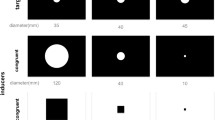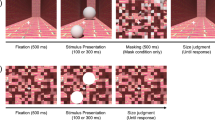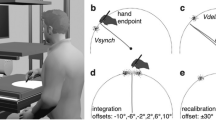Abstract
Recent models of the visual system in primates suggest that the mechanisms underlying visual perception and visuomotor control are implemented in separate functional streams in the cerebral cortex. However, a little-studied perceptual illusion demonstrates that a motor-related signal representing arm position can contribute to the visual perception of size. The illusion consists of an illusory size change in an afterimage of the hand when the hand is moved towards or away from the subject. The motor signal necessary for the illusion could be specified by feedforward and/or feedback sources (i.e. efference copy and/or proprioception/kinesthesis). We investigated the nature of this signal by measuring the illusion's magnitude when subjects moved their own arm (active condition, feedforward and feedback information available), and when arm movement was under the control of the experimenter (passive condition, feedback information available). Active and passive movements produced equivalent illusory size changes in the afterimages. However, the illusion was not obtained when an afterimage of subject's hand was obtained prior to movement of the other hand from a very similar location in space. This evidence shows that proprioceptive/kinesthetic feedback was sufficient to drive the illusion and suggests that a specific three-dimensional registration of proprioceptive input and the initial afterimage is necessary for the illusion to occur.
Similar content being viewed by others
References
Anderson RA, Bracewell RA, Barash M, Gnadt JW, Fogassi L (1990) Eye position effects on visual, memory and saccade-related activity in areas LIP and 7a of macaque. J Neurosci 10:1176–1196
Brindley GS, Goodwin GM, Kulikowski JJ, Leighton D (1976) Stability of vision with a paralyzed eye (abstract). J Physiol (Lond) 258:65P-66P
Cohen L, Gray F, Meyrignac C, Dehaene S, Degos JD (1994) Selective deficit of visual size perception — 2 cases of hemimicropsia. J Neurol Neurosurg Psychiatry 57:73–78
Colby CL, Duhamel J-R, Goldberg ME (1993) The analysis of visual space by the lateral intraparietal area of the monkey: the role of extraretinal signals. In: Hicks TP, Molotchnikoff S (eds) The visually responsive neuron: from basic neurophysiology to behavior. (Progress in Brain Research, vol 95) Elsevier, Amsterdam, pp 307–316
Davies P (1973) Effects of movements upon the appearance and duration of a prolonged visual afterimage. 1. Changes arising from the movement of a portion of the body incorporated in the afterimaged scene. Perception 2:147–153
Dizio P, Lathan CE, Lackner JR (1993) The role of brachial muscle-spindle signals in assignment of visual direction. J Neurophysiol 70:1578–1584
Dwyer J, Ashton R, Broerse J (1990) Emmert's law in the Ames room. Perception 19:35–41
Edwards W, Boring E (1951) What is Emmert's law? Am J Psychol 64:416–422
Erkelens CJ, Van der Steen J, Steinman RM, Collewijn H (1989) Ocular vergence under natural conditions. I. Continuous changes of target distance along the median plane. Proc R Soc Lond [Biol] 236:417–440
Galletti C, Battaglini PP, Fattori P (1993) Parietal neurons encoding spatial locations in craniotopic coordinates. Exp Brain Res 96:221–229
Goodale MA, Milner AD (1992) Separate visual pathways for perception and action. Trends Neurosci 15:20–25
Goodale MA, Milner AD, Jakobson LS, Carey DP (1991) A neurological dissociation between perceiving objects and grasping them. Nature 349:154–156
Gregory RL, Wallace JG, Campbell FW (1959) Changes in the size and shape of visual after-images observed in complete darkness during changes of position in space. Q J Exp Psychol 11:54–55
Holway AH, Boring EG (1941) Determinants of apparent visual size with distance variant. Am J Psychol 54:21–37
Humphrey NK, Weiskrantz L (1969) Size constancy in monkeys with inferotemporal lesions. Q J Exp Psychol 21:225–238
Ingling CR Jr, Grigsby SS (1990) Perceptual correlates of magnocellular and parvocellular channels: Seeing form and depth in afterimages. Vision Res 30:823–828
Jakobson LS, Goodale MA (1991) Factors affecting higher-order movement planning: a kinematic analysis of human prehension. Exp Brain Res 86:199–208
Jeannerod M (1981) Intersegmental coordination during reaching at natural objects. In: Long J, Baddeley A (eds) Attention and performance IX. Erlbaum, Hillsdale, NJ, pp 153–168
Jeannerod M, Rossetti Y (1993) Visuomotor coordination as a dissociable visual function: experimental and clinical evidence. Baillieres Clin Neurol 2:439–460
Jeannerod M, Kennedy H, Magnin M (1979) Corollary discharge: its possible implications in visual and oculomotor interactions. Neuropsychologia 17:241–258
Koken PW, Erkelens CJ (1993) Simultaneous hand tracking does not affect human vergence pursuit. Exp Brain Res 96:494–500
Matin L (1976) A possible hybrid mechanism for modification of visual direction associated with eye movements — the paralyzed eye experiment reconsidered. Perception 5:233–239
Merigan WH, Maunsell JHR (1993) How parallel are the primate visual pathways? Annu Rev Neurosci 16:369–402
Milner AD, Goodale MA (1995) The visual brain in action. Oxford University Press, Oxford
Paillard J, Brouchon M (1974) A proprioceptive contribution to the spatial encoding of position cues for ballistic movements. Brain Res 71:273–284
Roll R, Velay JL, Roll J-P (1991) Eye and neck proprioceptive messages contribute to the spatial coding of retinal input in visually oriented activities. Exp Brain Res 85:423–431
Siegal S, Castellan NJ Jr (1988) Nonparametric statistics for the behavioral sciences, 2nd edn. McGraw-Hill, New York
Steinbach MJ (1987) Proprioceptive knowledge of eye position. Vision Res 27:1737–1744
Taylor FV (1941) Change in siz of the after-image induced in total darkness. J Exp Psychol 29:75–80
Ungerleider LG, Mishkin M (1982) Two cortical visual systems. In: Ingle DJ, Goodale MA, Mansfield RWJ (eds) The analysis of visual behavior. MIT Press, Cambridge, MA, pp 549–585
Ungerleider LG, Ganz L, Pribram KH (1977) Size constancy in rhesus monkeys: effects of pulvinar, prestriate, and inferotemporal lesions. Exp Brain Res 27:251–269
Wyke M (1960) Alterations of size constancy associated with brain lesions in man. J Neurol Neurosurg Psychiatry 23:253–261
Author information
Authors and Affiliations
Rights and permissions
About this article
Cite this article
Carey, D.P., Allan, K. A motor signal and “visual” size perception. Exp Brain Res 110, 482–486 (1996). https://doi.org/10.1007/BF00229148
Received:
Accepted:
Issue Date:
DOI: https://doi.org/10.1007/BF00229148




